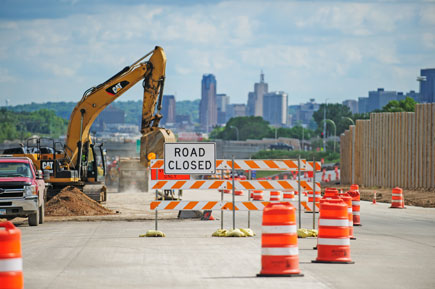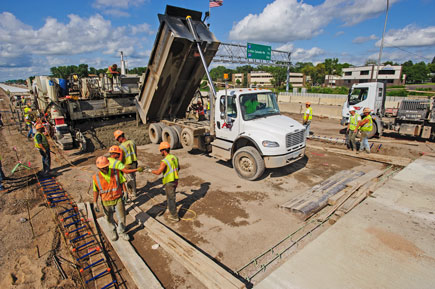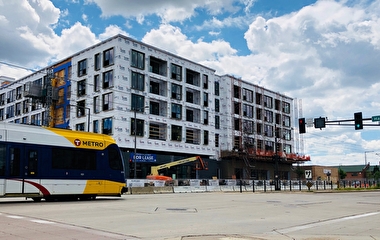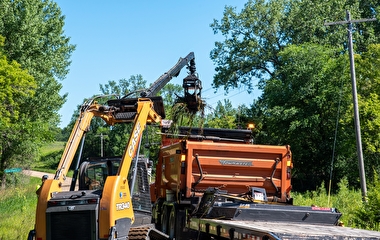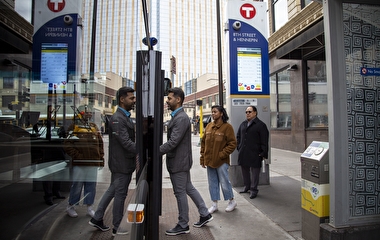Based in part on a planning study conducted by U of M researchers at the Humphrey School of Public Affairs, the Minnesota Department of Transportation (MnDOT) is extending MnPASS Express Lanes on Interstate 35E in the northeast Twin Cities. The extension will build on the project currently adding MnPASS lanes from Cayuga Street to Little Canada Road.
The study, funded by MnDOT and the Federal Highway Administration (FHWA), examined the feasibility of extending these MnPASS lanes from Little Canada Road north to County Road 96. During peak periods, MnPASS lanes provide a congestion-free option to transit vehicles, carpools, and motorcycles at no cost—and to single-occupant vehicles for a fee.
Led by Director Lee Munnich and Associate Director Frank Douma of the Humphrey School’s State and Local Policy Program, the U of M research team worked with Parsons Brinckerhoff to develop and evaluate several concepts for the MnPASS extension. The goal was to provide an option that reduced congestion for all users, including drivers in the general-purpose traffic lanes and transit users. The team also included Mary Vogel from the U’s Center for Changing Landscapes.
adding express lanes between St. Paul and Little Canada. Photo:
David Gonzalez, MnDOT
The primary challenge was how to handle MnPASS traffic through the recently reconstructed I-694/I-35E interchange. Initially, options included continuing the MnPASS lanes through the interchange, suspending them through the interchange, or converting the shoulder through the interchange into a MnPASS lane during peak periods. However, traffic modeling showed that all of these options pushed the northbound traffic bottleneck further upstream, so the team created a fourth “hybrid” option.
“The hybrid option creates a continuous southbound MnPASS lane and a discontinuous northbound MnPASS lane through the interchange. It also extends the northbound MnPASS lane one exit further north than originally planned, to County Road J,” Douma says. “We found that this option significantly improved the level of service for the afternoon peak and produced the highest cost/benefit analysis results.”
Researchers also engaged community stakeholders and corridor users to gather feedback about the proposed alternatives and worked to illustrate options that could facilitate greater transit, carpool, and vanpool use in communities along this section of I-35E.
Using this information, a team of representatives from MnDOT, the FHWA, the Metropolitan Council, and the U of M—with guidance from technical advisory and steering committees—developed a set of recommendations for the MnPASS extension. The recommendations included implementing the “hybrid” concept; continuing to educate community motorists about the MnPASS program; and expanding transit options by creating more park-and-ride sites, encouraging mixed land uses, and building better walking and biking connections.
Based on these recommendations, MnDOT is moving forward with the hybrid option for the project, says Brad Larsen, director of the MnPASS Policy and Planning Program. MnPASS lanes will be added to southbound I-35E between County Road 96 and Little Canada Road; through the I-35E/I-694 commons area, the existing inside lane will be designated as a MnPASS lane during peak periods. There will be no MnPASS lane northbound through the commons area, but a lane will be added north of the interchange from County Road E to County Road J.
“This study is a good example of how effective planning and analysis can cultivate action on a valuable transportation improvement,” Larsen says. “Without the study, it’s unlikely the 35E MnPASS extension project would have been advanced or its numerous benefits realized any time in the near future. We also anticipate that the land-use and transit enhancement component of the study will result in benefits that will serve the corridor for years to come.”
Construction on the extension project is expected to begin in March 2016, with the lanes slated to open in late 2016.
